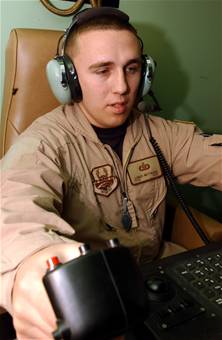
SAN FRANCISCO — Google Inc. tweaked its online advertising formula and accelerated its growth outside the United States to produce a first-quarter profit that surpassed analysts' predictions, alleviating some of the economic worries battering its stock this year.
The news, released after the stock market closed Thursday, lifted Google's recently drooping shares by more than $76, or 17 percent.
"This is mostly a relief rally," said Stanford Group analyst Clayton Moran. "People are relieved that things aren't as bad as they thought."
Google's global appeal propelled the Mountain View-based company as more than half its revenue came from outside the United States for the first time in its 9 1/2-year history.
The Internet search leader said it earned $1.31 billion, or $4.12 per share, during the first three months of the year. That represented a 30 percent increase from net income of $1 billion, or $3.18 per share, in the first quarter of 2007.
If not for expenses to cover stock given its employees, Google said it would have made $4.84 per share.
That figure outstripped the average projection of $4.52 per share among analysts surveyed by Thomson Financial.
First-quarter revenue totaled $5.19 billion, up 42 percent from $3.66 billion a year ago.
After subtracting the commissions paid to the company's advertising partners, Google's revenue stood at $3.7 billion _ about $100 million above analyst estimates.
"It's clear we are well positioned for 2008 and beyond, regardless of the business environment we are surrounded by," Google Chief Executive Eric Schmidt told analysts during a Thursday conference call.
Some analysts and investors, though, remain cautious because so much of Google's ad revenue comes from small and mid-sized businesses, which are more apt to curb their spending if the economy worsens.
"The fact Google hasn't seen a slowdown yet just means that there might be another shoe to drop," said Darren Chervitz, co-manager and research director for the Jacob Internet Fund, which has sold about half of its Google holdings in recent months.
Google's first-quarter showing could be a precursor to a strong earnings report from Yahoo Inc. next week.
If it can meet or exceed analyst expectations like Google did, Yahoo will be in a better position to ward off Microsoft Corp.'s unsolicited takeover bid or at least argue for its suitor to raise the cash-and-stock offer from its current value of about $42 billion.
Google is trying to help Sunnyvale-based Yahoo thwart Microsoft by helping Yahoo place ads on its Web site as part of a test scheduled to conclude next week. Schmidt declined to answer a question about the chances of Google signing a long-term advertising contract with Yahoo _ a deal that would likely face intense scrutiny from antitrust regulators.
"It's nice to be working with Yahoo," Schmidt said. "We like them very much."
Investors had serious doubts about Google's short-term prospects before Thursday.
The financial targets that guide Wall Street's expectations had fallen during the past two months as Web surfing data convinced analysts that Google's advertising links aren't attracting as much consumer interest amid mounting evidence the U.S. economy had tumbled into a recession. Google makes money from the links only when Web surfers click on them.
But management has said the slowdown in ad clicking largely reflected changes that purposefully reduced the volume of commercial in an effort to deliver more compelling messages that lead to purchases.
By making this switch, Google bet that advertisers would be willing to pay more for each ad link and ultimately generate more revenue from fewer clicks.
That appears to be what happened in the first quarter when the company said the number of paid clicks from last year rose by 20 percent, less than half the rate of the first-quarter revenue increase.
Google's performance indicates the Internet's advertising market _ expected to generate $44 billion in worldwide spending this year _ remains robust, especially outside the United States.
International markets accounted for 51 percent of Google's revenue in an expansion that was accentuated by the weak dollar. Google said its revenue would have been about $202 million lower if the dollar's value hadn't declined so dramatically from the first quarter of 2007.
As it was, Google's international revenue surged by about 50 percent from last year's first quarter compared with about 30 percent in the United States.
An unusually low tax rate of 24 percent also bolstered Google's earnings. The company's quarterly tax rate ranged from 25 percent to 27 percent last year. Management attributed this year's lower rate primarily to its widening exposure to markets outside the United States.
The results restored some of the $75 billion in shareholder wealth that had evaporated with the 35 percent drop in Google's stock price this year.
Google shares declined $5.49 during regular trading to finish at $449.54 before the company released its pleasant surprise.
This was the 12th quarter out of the 15 since Google went public that its performance has topped analyst expectations _ a trend that had helped propel its stock to nearly $750 before the recent plunge.






 China's statements come at a time when the country is still widely criticized for not doing enough to combat piracy. A year ago, US Trade Representative Susan Schwab
China's statements come at a time when the country is still widely criticized for not doing enough to combat piracy. A year ago, US Trade Representative Susan Schwab 









